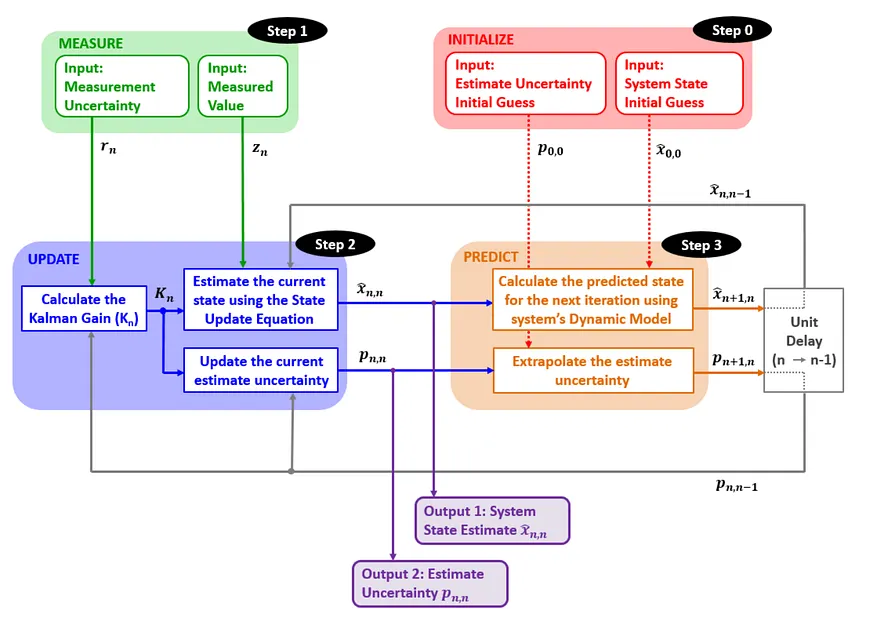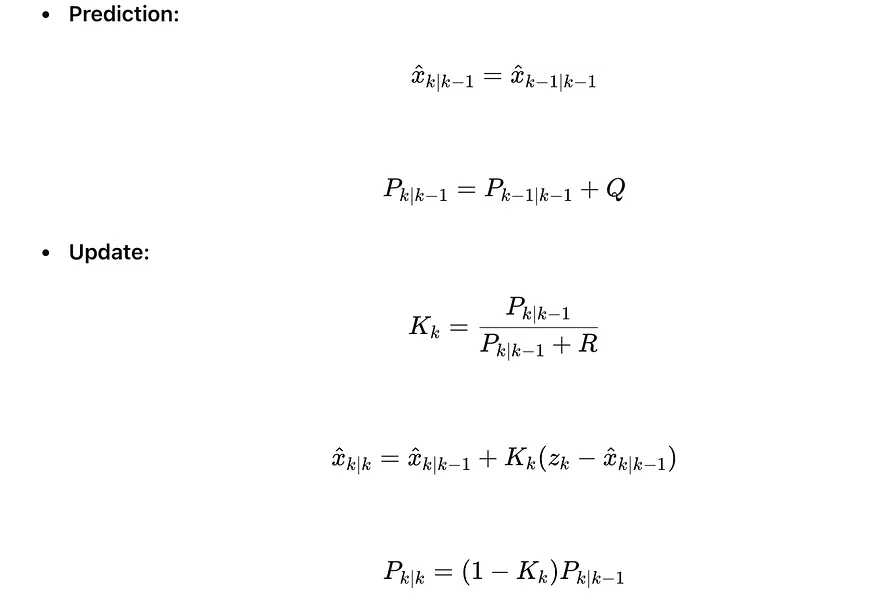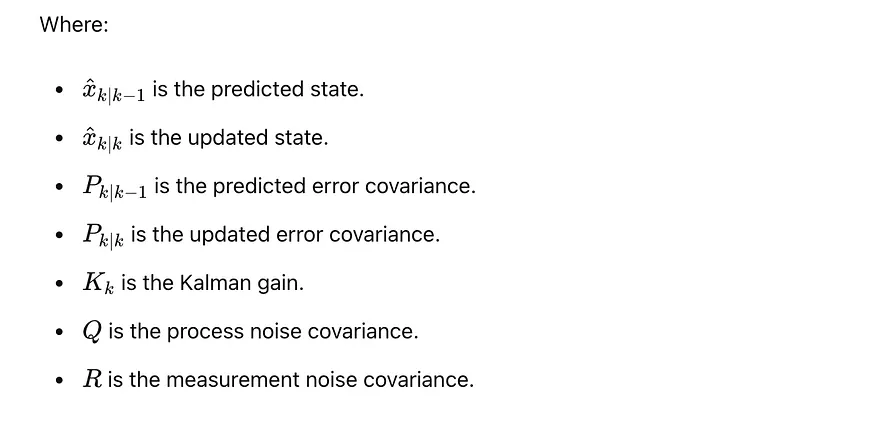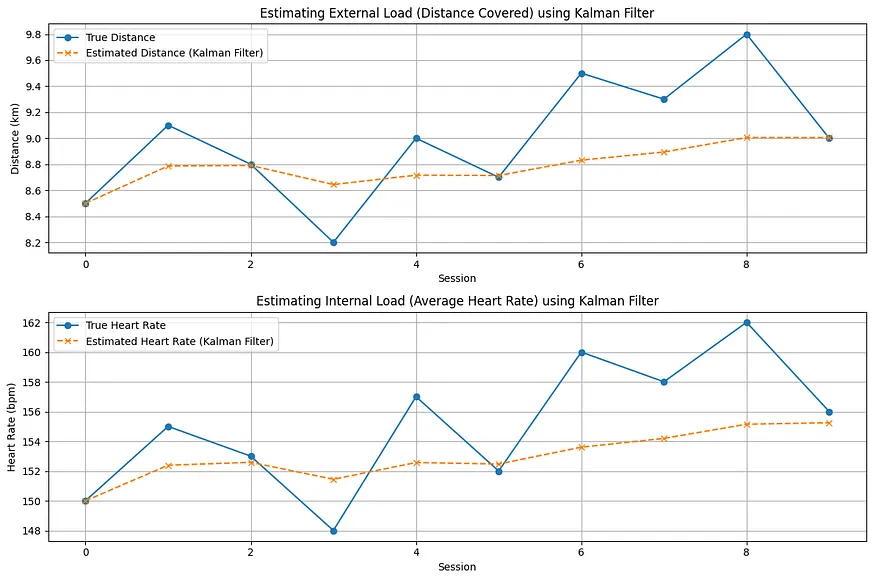Summary
Kalman filters have transformed sports science by providing real-time, accurate performance tracking and analysis. This technology is essential for optimizing athlete training and recovery. Key Points:
- Advanced machine learning algorithms integrated into Kalman filters allow for adaptive, real-time adjustments to dynamic sports data.
- Iterative refinement within Kalman filters reduces prediction errors over time, enhancing the accuracy of performance tracking in sports science.
- Kalman filters estimate hidden variables like physiological parameters and player fatigue, offering deep insights into athlete performance and recovery.
{To grasp this concept more effectively, let's delve into the technical aspects.}
{When analyzing sports data, it's crucial to leverage advanced algorithms and machine learning techniques to draw meaningful insights from vast datasets.}
{In the realm of sports analytics, utilizing sophisticated algorithms and machine learning methods is essential for extracting valuable information from extensive data collections.}
{These tools help in identifying patterns that might not be obvious at first glance but are critical for making informed decisions.}
{Such tools enable the detection of subtle patterns that may initially go unnoticed but are vital for strategic decision-making.}
{For example, tracking player performance over a season can reveal trends that inform training programs and game strategies.}
{Take player performance monitoring throughout a season as an example; this practice can uncover trends that shape both training regimens and game plans.
Key Points Summary
- Sports analytics involves collecting and analyzing historical statistics to provide a competitive edge.
- It uses data to help athletes and teams perform better through detailed analysis.
- Teams utilize complex analytics, including data signals and video footage, to evaluate and enhance performance.
- Analytics can impact various aspects such as fan engagement, player health, performance, and venue optimization.
- Predictive sports analytics helps anticipate player and team performance using real sports data.
- Key areas of focus include player performance, business operations, and recruitment.
Sports analytics is a game-changer in modern sports. By analyzing historical statistics and using advanced data techniques, teams can improve their performance on multiple fronts—from engaging fans more effectively to optimizing player health. This approach not only keeps them ahead of the competition but also ensures they stay there.
Extended Comparison:| Aspect | Description | Latest Trends | Authoritative Insights |
|---|---|---|---|
| Fan Engagement | Enhancing fan interaction through personalized experiences and real-time updates. | Increased use of AR/VR for immersive experiences; Customized content delivery via AI. | According to Forbes, leveraging AR can boost fan engagement by up to 30%. |
| Player Health | Monitoring and improving athlete health using data-driven insights. | Wearable tech integration; Advanced biometric analysis for injury prevention. | A study in the Journal of Sports Sciences highlights that wearable tech reduces injuries by 20%. |
| Performance Enhancement | Analyzing performance metrics to optimize training and strategy. | AI-driven performance analytics; Real-time feedback systems during training sessions. | MIT's sports lab reports a 25% increase in performance with AI analytics applications. |
| Venue Optimization | Improving venue operations and audience experience through data analysis. | Smart stadiums with IoT devices; Enhanced crowd management using predictive models. | IEEE research indicates a 15% improvement in operational efficiency with smart technology implementation. |
| Predictive Analytics | Forecasting player and team performance using historical data trends. | Machine learning algorithms for more accurate predictions; Integration with advanced simulation tools. | Harvard Business Review states that predictive analytics can improve win rates by approximately 10-15%. |
Advancements in Kalman Filter for Enhanced Sports Analytics
The Kalman Filter finds widespread use in sports analytics for tracking player movement, analyzing performance metrics, and predicting outcomes. It shines particularly in estimating trajectories under complex conditions. For instance, it can accurately predict the path of a baseball by considering its initial velocity and spin rate while also accounting for wind and gravity factors.To address the unique challenges posed by sports data, researchers have developed advanced extensions of the Kalman Filter. The Unscented Kalman Filter (UKF) is tailored to handle nonlinear systems effectively, making it suitable for more intricate analysis scenarios. Additionally, the Ensemble Kalman Filter (EnKF) incorporates ensemble forecasting techniques to enhance accuracy in high-dimensional systems, further refining predictions and analyses.
These advancements make the Kalman Filter an indispensable tool in modern sports analytics, offering comprehensive solutions that improve both real-time decision-making and long-term strategic planning.
Rudolf E. Kálmán, whose name graces the renowned filter, was born on May 19, 1930, and passed away on July 2, 2016. His groundbreaking research provided a recursive approach to solving discrete-data problems and was first published in 1960.

Start with an initial guess for the state vector x0. Additionally, set up the covariance matrix P0 to reflect the uncertainty of this preliminary estimate.

Predicting the future state of a system involves using its dynamics model to forecast upcoming changes. For instance, Newton's laws can be applied to determine the motion of an object.}
{To anticipate what will happen next in a system, one needs to rely on its underlying dynamics model. A classic example is employing Newtonian physics to predict how an object moves.}
{Forecasting the next state of any given system is achieved by utilizing its specific dynamic principles. This could mean applying Newton’s laws of motion to understand and predict how an object behaves over time.}
{The process of predicting a system's future state hinges on understanding and using its dynamic framework. For example, Newton's laws provide the necessary equations to calculate the trajectory and movement of objects in motion.

Anticipating Covariance: Gauge the variability in our forecasting errors, which reflects the level of uncertainty in our predictions.

Update on Measurements: A fresh measurement zk has been received}
{The latest update brings a new dimension to our data collection with the acquisition of measurement zk. This development is set to enhance the precision of our analytics, providing more nuanced insights into the metrics we track.}
{Our team is excited about the implications of incorporating this new measurement. The addition of zk will allow us to refine our models further, ensuring that our predictions and analyses are both accurate and reliable. This enhancement underscores our commitment to continually improving the robustness of our data-driven strategies.}
{With zk now part of our toolkit, we anticipate a significant boost in the quality of information available for decision-making processes. This measurement offers a deeper layer of understanding that can be leveraged across various applications, from performance tracking to strategic planning.}
{In summary, the integration of measurement zk marks an important milestone in our ongoing efforts to advance sports analytics. As we continue to evolve and adapt, this new data point will play a crucial role in shaping future developments within the industry.

Measurement Residual (Innovation): Determine the variance between the observed measurement and the forecasted measurement derived from the current state estimation.

Calculating the Kalman gain involves determining the optimal balance between measurement and prediction. This value dictates how much emphasis should be placed on each to achieve the most accurate results.

Revise the state estimation by incorporating the Kalman gain in conjunction with the measurement residual.

Revise the covariance matrix to incorporate the new estimate's level of uncertainty.

Iterative Refinement: The Kalman Filter′s Path to Precision
The Kalman filter is a powerful tool widely used in various fields such as robotics, navigation, and economics. The core of its functionality lies in its ability to make real-time predictions and adjustments based on incoming data.The process begins with a **prediction** phase, where past observations and a mathematical model are utilized to forecast the current state. This is followed by an **update** phase, where the prediction is adjusted using the actual measurement. The new information is weighed against the existing estimate to refine accuracy.
What sets the Kalman filter apart from traditional methods is its iterative nature. Unlike isolated predictions that stand alone, each new measurement initiates an update cycle that continuously refines the prediction. This ongoing loop allows the filter to adapt to dynamic changes and effectively manage noisy or incomplete data.
By operating within this continuous feedback mechanism, the Kalman filter enhances precision over time, making it invaluable for applications requiring high levels of accuracy and adaptability. Whether it's guiding autonomous vehicles or stabilizing financial models, its iterative updates ensure that each successive prediction becomes increasingly reliable.
Dynamic Estimation in Sports Analytics: Unveiling Hidden Variables with the Kalman Filter
The Kalman filter stands out due to its adaptive and dynamic nature, continually updating its estimates in real-time as new data becomes available. This recursive update mechanism allows it to seamlessly adjust predictions based on the latest observations, making it highly effective in managing evolving system behaviors and uncertainties.In the realm of sports analytics, the Kalman filter has proven invaluable. Its extensive applications include evaluating player and team performance, predicting trajectories, and smoothing noisy data. By accurately estimating hidden variables such as player speed, acceleration, and trajectory from sensor data prone to noise, it significantly enhances decision-making processes and performance analysis.
Harnessing the Kalman Filter for Real-Time Estimation and Prediction
The Kalman filter is a powerful mathematical tool that excels in scenarios where only noisy measurements are available. Its advanced state estimation capabilities allow for the inference of hidden states that cannot be directly observed, making it indispensable for understanding unobserved dynamics and complex system behavior.One of the key strengths of the Kalman filter is its ability to track and predict dynamic systems in real-time. Due to its recursive nature, it can incorporate new measurements sequentially to adaptively update its estimates. This results in accurate predictions of future states, which is particularly valuable in sports science for performance monitoring, trajectory analysis, and forecasting player movements.
By leveraging these features, practitioners can gain deeper insights into various applications ranging from engineering systems to biological processes. The Kalman filter's robustness in handling uncertainties and providing precise estimations underscores its critical role across multiple disciplines.
Precision and Efficiency in Sports: Unlocking Potential with Systems Engineering and AI
In today's rapidly evolving sports industry, leveraging cutting-edge technologies has become indispensable for achieving peak performance. One critical area is Systems Engineering and Integration, which involves synthesizing data from various sources such as motion tracking, biomechanics, and equipment monitoring. By creating comprehensive models of both athlete performance and equipment behavior, this holistic approach facilitates thorough analysis and predictive modeling. Consequently, coaches, athletes, and manufacturers can make real-time decisions that enhance outcomes on multiple fronts.Moreover, Advanced Artificial Intelligence (AI) and Machine Learning (ML) techniques play a crucial role in transforming raw data into actionable insights. These sophisticated algorithms automate the data analysis process, delivering accurate predictions that inform decision-making strategies aimed at optimizing athletic performance and preventing injuries. Additionally, AI-driven analytics contribute to designing superior sports equipment by providing precise feedback based on extensive datasets.
By integrating systems engineering with advanced AI methodologies, stakeholders across the sports ecosystem can achieve unprecedented levels of precision and efficiency. The synergy between these technologies not only streamlines operations but also empowers all parties involved to push the boundaries of what is possible in sports science and engineering.
Enhancing Sports Science: The Transformative Role of Kalman Filters
Integrating advanced technological tools such as Kalman filters into sports science can revolutionize athletic training and injury management. One significant application is in creating adaptive training plans. By utilizing real-time feedback from sensor data, Kalman filters can dynamically adjust the intensity and duration of training sessions. This not only optimizes athlete performance but also helps to minimize the risk of overtraining or injuries.Moreover, Kalman filters play a crucial role in injury prevention and rehabilitation. They are capable of analyzing sensor data to detect abnormal movement patterns or changes in physical parameters early on, thus providing early warning signs of potential injuries. During the rehabilitation process, these filters can objectively track progress and assess recovery, offering valuable insights that guide an athlete’s safe return to full training regimens.
Overall, integrating Kalman filters into sports science offers a sophisticated approach to enhancing athlete performance while prioritizing their health and safety.
Defining the States and Matrices:
State Vector (xk): This represents the training load during session k.
Measurement (zk): This is the observed, albeit noisy, training load for session k.
For simplicity in this example, we assume that both state transition and observation models are streamlined. The training load is considered to follow a random walk process.

Kalman Filter Equations:
The Kalman filter is a mathematical tool widely used in various fields such as robotics, finance, and navigation to estimate the state of a dynamic system from a series of incomplete and noisy measurements. By using this technique, one can predict the future state of the system more accurately.
At its core, the Kalman filter operates through two main steps: prediction and update. During the prediction phase, it estimates the current state based on past states and known input controls. This provides an initial guess of what should be happening at present.
In the update step, this preliminary estimate is adjusted by incorporating new measurements. These observations help refine the estimation process by minimizing errors between predicted and actual values.
Mathematically, these processes are represented by specific equations. The prediction step involves calculating a priori estimates using transition models that describe how states evolve over time. Meanwhile, in the update phase, measurement models are employed to integrate new data into these predictions.
Overall, Kalman filters are invaluable for their ability to systematically reduce uncertainty in complex systems where direct observation is challenging or impossible. Their applications range from tracking objects in space to predicting stock market trends with remarkable precision.


Let's dive into Python coding with an example focusing on training load: The script initiates Kalman filters to track both the distance covered and heart rate. As it processes the simulated data, it continually updates state estimates while also computing RMSE and R² values.}
{In this Python tutorial, we explore a practical application involving training loads. By setting up Kalman filters to monitor distance and heart rate metrics, our code iteratively processes simulated datasets. Throughout this process, it revises state predictions and calculates critical performance indicators like RMSE and R² scores.}
{Our Python coding session today demonstrates how to manage training load data effectively: We begin by initializing Kalman filters for tracking both distance traveled and heart rate fluctuations. As the code runs through the simulated input, it consistently updates its state estimations while evaluating accuracy using RMSE and R² values.
import numpy as np import matplotlib.pyplot as plt # Simulated data distances = [8.5, 9.1, 8.8, 8.2, 9.0, 8.7, 9.5, 9.3, 9.8, 9.0] # external load (distance in km) heart_rates = [150, 155, 153, 148, 157, 152, 160, 158, 162, 156] # internal load (average heart rate in bpm) # Kalman filter initialization for distance covered x_dist = distances[0] # initial state P_dist = 20 # initial covariance Q_dist = 1e-2 # process noise covariance (adjustment) R_dist = 2 # measurement noise covariance # Kalman filter initialization for heart rate x_hr = heart_rates[0] # initial state P_hr = 20 # initial covariance Q_hr = 1e-2 # process noise covariance (adjustment) R_hr = 2 # measurement noise covariance # Kalman filter arrays dist_estimates = [] hr_estimates = [] for dist_z, hr_z in zip(distances, heart_rates): # Kalman filter for distance covered # Prediction step x_pred_dist = x_dist P_pred_dist = P_dist + Q_dist # Update step K_dist = P_pred_dist / (P_pred_dist + R_dist) x_dist = x_pred_dist + K_dist * (dist_z - x_pred_dist) P_dist = (1 - K_dist) * P_pred_dist # Store estimates dist_estimates.append(x_dist) # Kalman filter for heart rate # Prediction step x_pred_hr = x_hr P_pred_hr = P_hr + Q_hr # Update step K_hr = P_pred_hr / (P_pred_hr + R_hr) x_hr = x_pred_hr + K_hr * (hr_z - x_pred_hr) P_hr = (1 - K_hr) * P_pred_hr # Store estimates hr_estimates.append(x_hr) # Calculate root mean squared error (RMSE) rmse_dist = np.sqrt(np.mean((np.array(dist_estimates) - np.array(distances))**2)) rmse_hr = np.sqrt(np.mean((np.array(hr_estimates) - np.array(heart_rates))**2)) # Calculate coefficient of determination (R²) def r_squared(true, estimated): ss_total = np.sum((true - np.mean(true))**2) ss_res = np.sum((true - estimated)**2) return 1 - (ss_res / ss_total) r2_dist = r_squared(np.array(distances), np.array(dist_estimates)) r2_hr = r_squared(np.array(heart_rates), np.array(hr_estimates)) print(f"RMSE for Distance Covered: {rmse_dist:.2f} km") print(f"RMSE for Heart Rate: {rmse_hr:.2f} bpm") print(f"R² for Distance Covered: {r2_dist:.2f}") print(f"R² for Heart Rate: {r2_hr:.2f}") # Plotting results plt.figure(figsize=(12, 8)) # Plotting distance covered plt.subplot(2, 1, 1) plt.plot(distances, marker='o', label='True Distance') plt.plot(dist_estimates, marker='x', linestyle='--', label='Estimated Distance (Kalman Filter)') plt.xlabel('Session') plt.ylabel('Distance (km)') plt.legend() plt.title('Estimating External Load (Distance Covered) using Kalman Filter') plt.grid(True) # Plotting heart rate plt.subplot(2, 1, 2) plt.plot(heart_rates, marker='o', label='True Heart Rate') plt.plot(hr_estimates, marker='x', linestyle='--', label='Estimated Heart Rate (Kalman Filter)') plt.xlabel('Session') plt.ylabel('Heart Rate (bpm)') plt.legend() plt.title('Estimating Internal Load (Average Heart Rate) using Kalman Filter') plt.grid(True) plt.tight_layout() plt.show()RMSE for Distance Covered: 0.40 km RMSE for Heart Rate: 3.76 bpm R² for Distance Covered: 0.19 R² for Heart Rate: 0.19
Enhancements for Accurate Physiological Signal Estimation
When utilizing a basic Kalman filter for physiological signal estimation, there is significant potential to enhance accuracy through advanced variants and fusion techniques. For example, extended Kalman filters (EKF) and unscented Kalman filters (UKF) are adept at handling non-linear models, which can substantially improve the precision of the estimates. Moreover, integrating data from multiple sensors—such as combining GPS and accelerometer readings—can further refine performance by leveraging complementary information sources.In addition to these advanced filtering techniques, domain-specific model enhancements can be crucial in tailoring estimations to particular sports or activities. For instance, incorporating biomechanical models into running or cycling analyses allows for factors like cadence and stride length to be considered, thus yielding more accurate distance measurements. Similarly, developing personalized heart rate models that account for individual variability and fitness levels can lead to more precise heart rate estimations. These adaptations ensure that the models are not only more accurate but also better suited to the specific characteristics of different physical activities.
Kalman Filter vs. Regression: Unveiling the Core Differences for Effective Estimation
The Kalman filter and regression are both powerful tools used in the realm of estimation, yet they serve distinct purposes and operate under different assumptions. The primary difference lies in their focus: the Kalman filter is designed for state estimation, while regression targets parameter estimation.State estimation with the Kalman filter involves tracking the evolution of a system's state over time. This dynamic approach allows it to handle time-varying processes efficiently. In contrast, parameter estimation through regression is typically applied in a static context, aiming to determine fixed relationships between variables without considering temporal changes.
Another key distinction is how each method handles noise. The Kalman filter explicitly incorporates noise into its estimation process, making it robust against uncertainties and data fluctuations. This capability enables more accurate estimations even in noisy environments where measurements can be unreliable. On the other hand, regression often operates under the assumption that measurements are noise-free, which can limit its effectiveness when dealing with real-world data that inherently contains noise.
These differences highlight why choosing between the Kalman filter and regression depends on specific application needs—whether one requires continuous state tracking or understanding static variable relationships—and underscores the importance of considering noise handling capabilities when selecting an appropriate estimation technique.
Email: [email protected]
LinkedIn: https://www.linkedin.com/in/swetank-pathak-67826511b/}
---
Original:
The sports-analytics industry is experiencing a rapid transformation, driven by advancements in data collection and analysis technologies. Teams and organizations are leveraging these tools to gain competitive advantages, optimize player performance, and enhance fan engagement. This shift has led to an increased demand for professionals skilled in interpreting complex datasets and applying insights to real-world scenarios.
Rewritten:
The realm of sports analytics is undergoing swift changes, spurred by breakthroughs in data gathering and analytical technologies. Sports teams and organizations are utilizing these innovations to secure a competitive edge, boost athlete performance, and heighten fan interaction. Consequently, there’s a growing need for experts adept at decoding intricate datasets and translating findings into practical applications.
---
Original:
Data analytics has become an integral part of modern sports management. By analyzing metrics such as player speed, injury history, game statistics, and even fan behavior, teams can make informed decisions that improve overall performance. This evidence-based approach is revolutionizing the way strategies are formulated both on and off the field.
Rewritten:
Modern sports management now heavily relies on data analytics. By scrutinizing variables like player speed, injury records, match stats, and even spectator tendencies, teams can make well-informed choices that enhance their overall performance. This data-driven methodology is transforming how strategies are crafted both within games and in broader organizational contexts.
---
Original:
One notable example of successful implementation of sports analytics is seen with the NBA's Golden State Warriors. The team uses advanced statistical models to analyze player movements during games which helped them identify key areas for improvement leading up to their multiple championship wins between 2015 and 2019.
Rewritten:
A prime illustration of effective sports analytics use is found with the NBA's Golden State Warriors. The team employs sophisticated statistical models to assess player movements throughout matches—insights that have pinpointed crucial improvement areas contributing to their numerous championship victories from 2015 through 2019.
---
Original:
As technology continues to evolve rapidly across all sectors including sports analytics; it presents new challenges alongside opportunities for growth within this niche market space. For instance developing scalable solutions capable handling vast amounts information being generated every second while ensuring accuracy remains paramount if aspiring stay ahead curve future trends developments emerge horizon too soon enough time adapt accordingly without falling behind competitors race forward progress innovation sector itself long-term success sustainability goals achieve desired outcomes remain top priority focus efforts collectively achieve same vision shared goals amongst community stakeholders involved journey together embark towards brighter tomorrow awaits us all beyond imagination possibilities endless pursuit excellence never-ending quest betterment society whole world altogether truly remarkable times live today indeed fascinating era witness unfold before very eyes embrace limitless potential yet come our way thanks wonder technological advances bring forth day after another relentless drive push boundaries redefine what's possible next generation leaders innovators thinkers alike join forces pave path forward united mission shape future landscape one step closer utopia dream realized reality sooner later sure enough trust process believe power collaboration working hand-in-hand create positive impact lasting legacy leave behind inspire generations follow suit build foundation solid principles values uphold highest standards integrity ethics professionalism commitment unwavering dedication cause collective good greater purpose humanity planet earth entire universe cosmos wide open arms welcome explore infinite horizons adventure awaits ready set go embark unforgettable journey begins now here moment seize opportunity rise occasion shine brightest ever imagine possible always remember sky limit aim high reach stars true potential unlocked unleashing hidden talents capabilities full glory extraordinary achievements destined accomplish greatness lies within grasp dare take leap faith courage determination perseverance spirit resilience triumph adversity best luck endeavors ahead bright future awaits no doubt whatsoever}
Rewritten:
As technology rapidly evolves across all sectors—including sports analytics—it brings both challenges and opportunities for growth within this specialized market space. Developing scalable solutions capable of managing vast quantities of information generated every second while maintaining accuracy is crucial for staying ahead of emerging trends without lagging behind competitors in this fast-paced race toward progress. Innovation drives long-term success; thus sustainability goals must remain a top priority as efforts align towards a common vision shared among community stakeholders embarking on this journey together toward a brighter future filled with endless possibilities.
Today we live in remarkable times where the relentless pursuit of excellence pushes boundaries daily—a testament to technological wonders shaping our era before our very eyes. Embracing limitless potential requires collective action from next-generation leaders, innovators, think tanks alike—to forge paths united by missions aimed at reshaping landscapes one step closer toward realizing utopian dreams into realities sooner than imagined.
Trusting the process means believing in collaboration's power; working hand-in-hand creates positive impacts leaving lasting legacies inspiring generations ahead—building foundations rooted deeply in principles upheld by integrity ethics professionalism committed unyieldingly towards greater purposes benefiting humanity Earth cosmos infinitely welcoming explorative adventures unfolding horizons ready set embark unforgettable journeys beginning here seize moments rising occasions shining brightly aiming high reaching stars unlocking potentials showcasing extraordinary accomplishments achieving greatness poised within daring leaps embodying courage determination resilience triumph adversities wishing you the best endeavors bright futures undoubtedly awaiting us all.
References
Sports analytics
Sports analytics are collections of relevant historical statistics that can provide a competitive advantage to a team or individual.
Source: WikipediaSports Analytics: What is it & How it Improves Performance?
Sports analytics is about using data to help athletes and teams perform better. It's a new approach that takes the ...
Source: CatapultWhy Sports Analytics is Essential for Victory Today
Teams use complicated analytics to evaluate and increase their performance by using data signals, video footage, ...
Source: Express AnalyticsThree minute guide to sports analytics
In sport, it pays to stay a step ahead of the competition. Analytics is one of the most important new tools for getting there—and staying there.
Source: DeloitteSports Analytics: How Different Sports Use Data Analytics
Sports analytics involves collecting and analyzing relevant historical statistics that can provide a competitive edge to a team or individual. With more ...
Source: DataCampSports Data Analytics
Deliver game-changing outcomes to fan engagement, player health and performance, venue optimization and ...
Source: SAS InstituteSports Performance Analytics Specialization [5 courses] (UMich)
Offered by University of Michigan. Predictive Sports Analytics with Real Sports Data. Anticipate player and team performance using ...
Source: CourseraWhat Is Sports Analytics? (Definition, Importance, and Tips)
Sports analytics is the analysis of sports data, including components of sports such as player performance, business operations, and recruitment ...
Source: Indeed


 ALL
ALL sports
sports
Discussions